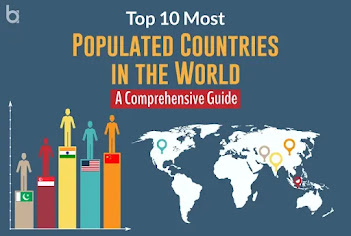The global population is distributed across various countries, each with its unique cultural heritage, socioeconomic challenges, and contributions to the world stage. Some countries stand out for their immense populations, shaping global demographics and influencing global trends. Let's take a comprehensive look at the most populous countries in the world, exploring their demographics, cultural richness, and key challenges.
China: China holds the distinction of being the most populous country globally, with a population exceeding 1.4 billion people. The nation's vast landscape encompasses bustling megacities like Beijing and Shanghai, as well as rural areas rich in traditional culture. Demographically, China faces challenges related to managing rapid urbanization, promoting sustainable development, and bridging economic disparities between regions.
India: India ranks as the second most populous country, with over 1.3 billion people representing a mosaic of languages, religions, and traditions. The country's cultural diversity is reflected in its vibrant festivals, arts, and culinary traditions. India grapples with demographic challenges such as healthcare accessibility, quality education for all, and balanced economic growth across rural and urban areas.
United States: The United States is the third most populous country, with a population exceeding 330 million individuals. Its cultural landscape is shaped by a blend of ethnicities, languages, and traditions from around the world. Demographic challenges in the U.S. include immigration policies, healthcare affordability and accessibility, and addressing socioeconomic disparities among different demographic groups.
Indonesia: Indonesia ranks as the fourth most populous country globally, with over 270 million people spread across its archipelago. The nation's cultural diversity is evident in its various ethnic groups, languages, and religious practices. Indonesia faces demographic challenges such as managing urbanization, preserving environmental resources, and promoting inclusive development across its diverse regions.
Pakistan: Pakistan holds the fifth position in global population rankings, with a population exceeding 220 million individuals. Its cultural heritage is deeply rooted in Islamic traditions, contributing to a rich tapestry of art, music, and literature. Demographic challenges in Pakistan include improving healthcare infrastructure, educational opportunities, and addressing socioeconomic disparities between urban and rural areas.
Brazil: Brazil is the sixth most populous country, with over 210 million people representing a blend of indigenous, European, and African cultural influences. The country's cultural richness is celebrated in its vibrant Carnaval, music, and culinary traditions. Demographic challenges such as income inequality, environmental conservation, and urban infrastructure development are key priorities for Brazil's sustainable growth.
Nigeria: Nigeria ranks as the seventh most populous country globally, with over 200 million inhabitants representing diverse ethnic groups and languages. Its cultural diversity is showcased in traditional arts, music, and vibrant festivals. Nigeria faces demographic challenges related to infrastructure development, healthcare access, and managing rapid urbanization while ensuring equitable development across regions.
Bangladesh: Bangladesh holds the eighth position in global population rankings, with over 160 million people residing in its densely populated areas. The nation's cultural heritage is reflected in its literature, music, and handicrafts. Demographic challenges in Bangladesh include poverty alleviation, climate resilience, and sustainable development amidst limited resources.
Russia: Russia is the ninth most populous country, with a population exceeding 145 million people spread across its vast territory. Its cultural diversity spans multiple ethnic groups, languages, and traditions. Demographic challenges in Russia include population aging, regional economic disparities, and diversifying the economy beyond natural resources.
Mexico: Mexico rounds out the top ten most populous countries, with over 125 million people representing a blend of indigenous and Spanish colonial heritage. The nation's cultural richness is evident in its art, architecture, and vibrant celebrations. Challenges such as migration management, urban development, and socioeconomic inequalities are focal points for Mexico's sustainable development efforts.
These populous countries contribute significantly to global demographics, economies, and cultural diversity. Addressing their demographic challenges while leveraging their cultural richness and contributions to global cooperation remains essential for fostering sustainable development and prosperity worldwide.




.jpg)

0 Comments